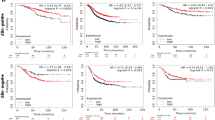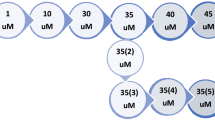Abstract
Purpose Two genes, TSC22 domain family, member 1 (TSC22D1) and prosaposin (PSAP) were identified in an in vitro functional screen for genes having a causative role in tamoxifen resistance. These genes were also present in our previously established 81-gene signature for resistance to first-line tamoxifen therapy. The aim of this study was to investigate the predictive value of these genes for tamoxifen therapy failure in patients with recurrent breast cancer. Experimental Design The mRNA levels of TSC22D1 and PSAP were analyzed by quantitative real-time polymerase chain reaction (qRT-PCR) in 223 estrogen receptor-positive primary breast tumors of patients with recurrent disease treated with first-line tamoxifen therapy. The main objective of this study was the length of progression-free survival (PFS). Results High mRNA levels of TSC22D1 and PSAP were significantly associated with shorter PFS and both were independent of the traditional predictive factors (HR = 1.30, 95% CI = 1.04–1.64 P = 0.023; and HR = 1.40, 95% CI = 1.03–1.88, P = 0.029, respectively). In multivariate analysis, patients with high mRNA levels of both genes associated significantly with no clinical benefit (OR = 0.19, 95% CI = 0.06–0.62, P = 0.006) and had the shortest PFS (HR = 2.05, 95% CI = 1.29–3.25, P = 0.002). Conclusion These results confirm our previous in vitro and tumor-related findings and are indicative for the failure of tamoxifen treatment in breast-cancer patients. Both TSC22D1 and PSAP are associated with clinical outcome and may have a functional role in therapy resistance.


Similar content being viewed by others
References
Loi S, Piccart M, Sotiriou C (2007) The use of gene-expression profiling to better understand the clinical heterogeneity of estrogen receptor positive breast cancers and tamoxifen response. Crit Rev Oncol Hematol 61:187–194
Paik S, Shak S, Tang G, Kim C, Baker J, Cronin M, Baehner FL, Walker MG, Watson D, Park T, Hiller W, Fisher ER, Wickerham DL, Bryant J, Wolmark N (2004) A multigene assay to predict recurrence of tamoxifen-treated, node-negative breast cancer. N Engl J Med 351:2817–2826
Ma XJ, Wang Z, Ryan PD, Isakoff SJ, Barmettler A, Fuller A, Muir B, Mohapatra G, Salunga R, Tuggle JT, Tran Y, Tran D, Tassin A, Amon P, Wang W, Enright E, Stecker K, Estepa-Sabal E, Smith B, Younger J, Balis U, Michaelson J, Bhan A, Habin K, Baer TM, Brugge J, Haber DA, Erlander MG, Sgroi DC (2004) A two-gene expression ratio predicts clinical outcome in breast cancer patients treated with tamoxifen. Cancer Cell 5:607–616
Jansen MP, Foekens JA, van Staveren IL, Dirkzwager-Kiel MM, Ritstier K, Look MP, Meijer-van Gelder ME, Sieuwerts AM, Portengen H, Dorssers LC, Klijn JG, Berns EM (2005) Molecular classification of tamoxifen-resistant breast carcinomas by gene expression profiling. J Clin Oncol 23:732–740
Meijer D, van Agthoven T, Bosma PT, Nooter K, Dorssers LC (2006) Functional screen for genes responsible for tamoxifen resistance in human breast cancer cells. Mol Cancer Res 4:379–386
van Agthoven T, van Agthoven TL, Portengen H, Foekens JA, Dorssers LC (1992) Ectopic expression of epidermal growth factor receptors induces hormone independence in ZR-75–1 human breast cancer cells. Cancer Res 52:5082–5088
Nicholson S, Sainsbury JR, Halcrow P, Chambers P, Farndon JR, Harris AL (1989) Expression of epidermal growth factor receptors associated with lack of response to endocrine therapy in recurrent breast cancer. Lancet 1:182–185
Atlas E, Cardillo M, Mehmi I, Zahedkargaran H, Tang C, Lupu R (2003) Heregulin is sufficient for the promotion of tumorigenicity and metastasis of breast cancer cells in vivo. Mol Cancer Res 1:165–175
Sieuwerts AM, Meijer-van Gelder ME, Timmermans M, Trapman AM, Garcia RR, Arnold M, Goedheer AJ, Portengen H, Klijn JG, Foekens JA (2005) How ADAM-9 and ADAM-11 differentially from estrogen receptor predict response to tamoxifen treatment in patients with recurrent breast cancer: a retrospective study. Clin Cancer Res 11:7311–7321
Martens JW, Nimmrich I, Koenig T, Look MP, Harbeck N, Model F, Kluth A, Bolt-de Vries J, Sieuwerts AM, Portengen H, Meijer-Van Gelder ME, Piepenbrock C, Olek A, Hofler H, Kiechle M, Klijn JG, Schmitt M, Maier S, Foekens JA (2005) Association of DNA methylation of phosphoserine aminotransferase with response to endocrine therapy in patients with recurrent breast cancer. Cancer Res 65:4101–4117
Hayward JL, Carbone PP, Heuson JC, Kumaoka S, Segaloff A, Rubens RD (1977) Assessment of response to therapy in advanced breast cancer: a project of the programme on clinical oncology of the international union against cancer, Geneva, Switzerland. Cancer 39:1289–1294
Meijer-van Gelder ME, Look MP, Peters HA, Schmitt M, Brunner N, Harbeck N, Klijn JG, Foekens JA (2004) Urokinase-type plasminogen activator system in breast cancer: association with tamoxifen therapy in recurrent disease. Cancer Res 64:4563–4568
Shibanuma M, Kuroki T, Nose K (1992) Isolation of a gene encoding a putative leucine zipper structure that is induced by transforming growth factor beta 1 and other growth factors. J Biol Chem 267:10219–10224
Shostak KO, Dmitrenko VV, Garifulin OM, Rozumenko VD, Khomenko OV, Zozulya YA, Zehetner G, Kavsan VM (2003) Downregulation of putative tumor suppressor gene TSC-22 in human brain tumors. J Surg Oncol 82:57–64
Nakashiro K, Kawamata H, Hino S, Uchida D, Miwa Y, Hamano H, Omotehara F, Yoshida H, Sato M (1998) Down-regulation of TSC-22 (transforming growth factor beta-stimulated clone 22) markedly enhances the growth of a human salivary gland cancer cell line in vitro and in vivo. Cancer Res 58:549–555
Rentsch CA, Cecchini MG, Schwaninger R, Germann M, Markwalder R, Heller M, van der Pluijm G, Thalmann GN, Wetterwald A (2006) Differential expression of TGFbeta-stimulated clone 22 in normal prostate and prostate cancer. Int J Cancer 118:899–906
Frasor J, Barnett DH, Danes JM, Hess R, Parlow AF, Katzenellenbogen BS (2003) Response-specific and ligand dose-dependent modulation of estrogen receptor (ER) alpha activity by ERbeta in the uterus. Endocrinology 144:3159–3166
Kester HA, van der Leede BM, van der Saag PT, van der Burg B (1997) Novel progesterone target genes identified by an improved differential display technique suggest that progestin-induced growth inhibition of breast cancer cells coincides with enhancement of differentiation. J Biol Chem 272:16637–16643
Choi SJ, Moon JH, Ahn YW, Ahn JH, Kim DU, Han TH (2005) Tsc-22 enhances TGF-beta signaling by associating with Smad4 and induces erythroid cell differentiation. Mol Cell Biochem 271:23–28
Gupta RA, Sarraf P, Brockman JA, Shappell SB, Raftery LA, Willson TM, DuBois RN (2003) Peroxisome proliferator-activated receptor gamma and transforming growth factor-beta pathways inhibit intestinal epithelial cell growth by regulating levels of TSC-22. J Biol Chem 278:7431–7438
Buck MB, Knabbe C (2006) TGF-beta signaling in breast cancer. Ann N Y Acad Sci 1089:119–126
Pardali K, Moustakas A (2007) Actions of TGF-beta as tumor suppressor and pro-metastatic factor in human cancer. Biochim Biophys Acta 1775:21–62
O’Brien JS, Kishimoto Y (1991). Saposin proteins: structure, function, and role in human lysosomal storage disorders. Faseb J 5:301–308
Kishimoto Y, Hiraiwa M, O’Brien JS (1992) Saposins: structure, function, distribution, and molecular genetics. J Lipid Res 33:1255–1267
Campana WM, O’Brien JS, Hiraiwa M, Patton S (1999) Secretion of prosaposin, a multifunctional protein, by breast cancer cells. Biochim Biophys Acta 1427:392–400
Laurent-Matha V, Lucas A, Huttler S, Sandhoff K, Garcia M, Rochefort H (2002) Procathepsin D interacts with prosaposin in cancer cells but its internalization is not mediated by LDL receptor-related protein. Exp Cell Res 277:210–219
Misasi R, Sorice M, Di Marzio L, Campana WM, Molinari S, Cifone MG, Pavan A, Pontieri GM, O’Brien JS (2001) Prosaposin treatment induces PC12 entry in the S phase of the cell cycle and prevents apoptosis: activation of ERKs and sphingosine kinase. Faseb J 15:467–474
Misasi R, Garofalo T, Di Marzio L, Mattei V, Gizzi C, Hiraiwa M, Pavan A, Grazia Cifone M, Sorice M (2004) Prosaposin: a new player in cell death prevention of U937 monocytic cells. Exp Cell Res 298:38–47
Riggins RB, Schrecengost RS, Guerrero MS, Bouton AH (2007) Pathways to tamoxifen resistance. Cancer Lett 256:1–24
Massarweh S, Schiff R (2007) Unraveling the mechanisms of endocrine resistance in breast cancer: new therapeutic opportunities. Clin Cancer Res 13:1950–1954
Gartel AL (2006) Is p21 an oncogene? Mol Cancer Ther 5:1385–1386
Chang BD, Swift ME, Shen M, Fang J, Broude EV, Roninson IB (2002) Molecular determinants of terminal growth arrest induced in tumor cells by a chemotherapeutic agent. Proc Natl Acad Sci USA 99:389–394
Chang BD, Watanabe K, Broude EV, Fang J, Poole JC, Kalinichenko TV, Roninson IB (2000) Effects of p21Waf1/Cip1/Sdi1 on cellular gene expression: implications for carcinogenesis, senescence, and age-related diseases. Proc Natl Acad Sci USA 97:4291–4296
Acknowledgements
We acknowledge the contributions of Dr. Jozien Helleman, drs. Marion E. Meijer-van Gelder and Roya Sarwari. This research was supported, in part, by grants of the Association for International Cancer Research, the Susan G. Komen Breast Cancer Foundation, the Dutch Cancer Society, and the “Breedte-strategie” of the Erasmus MC.
Author information
Authors and Affiliations
Corresponding author
Additional information
Danielle Meijer and Maurice P.H.M. Jansen contributed equally to this work.
Rights and permissions
About this article
Cite this article
Meijer, D., Jansen, M.P.H.M., Look, M.P. et al. TSC22D1 and PSAP predict clinical outcome of tamoxifen treatment in patients with recurrent breast cancer. Breast Cancer Res Treat 113, 253–260 (2009). https://doi.org/10.1007/s10549-008-9934-3
Received:
Accepted:
Published:
Issue Date:
DOI: https://doi.org/10.1007/s10549-008-9934-3




